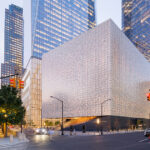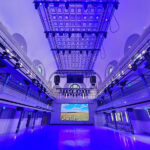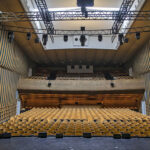Many of the students at Brigham Young University-Idaho in Rexburg can’t wait for the new 15,000-seat auditorium to open on campus. The senior class, in fact, can’t wait — it won’t open until 2009 in the earliest, and most will graduate before then. Not that there’s a lot of grumbling on campus. Students are aware that tithing dollars from faithful LDS Church followers around the world are funding the construction that surrounds them.
In the meantime, the social scene revolves around the 39-year old John W. Hart Building and its 4,300 seat auditorium. Once a gym, the Hart building has been reborn as the place to go for social dancing, or to see and hear musical and dance performances and to participate in weekly devotionals. It’s also the spot where those seniors will be gathering for commencement ceremonies later this spring.
Brent Pritchett, BYU-Idaho’s lighting designer, is in the second of a three-step upgrade plan, scheduled over three years to meet budgetary constraints. The first step, which was completed last year, included buffing up the venue’s lighting control system. This year’s work will include an upgrade of the distribution system and then, in 2009, the Hart building will get the final touches on a state of the art lighting system with rigging additions.
The Hart building isn’t shutting down amid the upgrades. In February, the building served as the venue for staged events including a performance by the Vienna Boys Choir and “Trek: Nashville Tribute to Pioneers,” a musical tribute to LDS Church founder Joseph Smith and his followers.
The goal of the upgrades, Pritchett says, is to support those events and more with a top-notch system that boasts redundancy. “On-campus entertainment is a big thing,” he says. “The school supports a lot of different events that come in to the campus as well as groups that perform here and go out and tour. So, this room needed to support any of those specific events and we can’t have a show go down because of lighting.”
Moreover, he says, “we like to add a bit of flash to these concerts, because they are student performances and it’s not necessarily the best quality. So, we try to put on a light show that can help.”
The install work done in 2007 included an upgrade in the venue’s control system, including a dimmer rack with processor upgrades, console upgrades and a handful of additional control options.
Pritchett is responsible for the system’s design and implementation, but students set up the events. The size of the space within the Hart building, and the fact that Pritchett relies on student crews, have dictated much of what Pritchett has installed there.
“It is a large room, so we have to train the students on all of the rigging aspects, how to fly a truss and how to take care of data distribution,” he says. “So, we wanted some standardization to the system so they would understand where things plug in on a regular basis without having to reconfigure the system constantly, depending on what kinds of events are happening.”
There are quite a few node locations in the Hart Building’s catwalks, Pritchett adds, and that makes it easier for students to plug in for data distribution.
Pritchett is using an MA Lighting GrandMA console as the main board and has a GrandMA Lite board for backup. Both are running ETC Net2 to eight universes.
As for fixtures, four Vari*Lite VL 1000 TSDs have been permanently hung from a front of house position. “That takes care of quite a bit,” he says, “from a spot on the stage to a toning wash during a dance.”
For concert performances, Pritchett brought in 12 Martin MAC 700 Wash fixtures to buff up a moving light system that already included eight MAC 550s and 14 RoboScan 918s. The lighting rig also features a number of ETC Source Four ellipsoidals, PARs and PARNels.
The university also bought a Martin Maxedia Compact digital media server as part of the upgrade. The content from the Maxedia is delivered to a 25- by 50-foot rear projection screen via either Epson 7900 or 8300 projectors, which were pulled from classroom stock. There are also two 4:3 format screens on either side of the stage that receive images from double stacked Epson 8300 projectors and four 50” plasma screens in parts of the room where the screens are not visible.
“We looked at quite a few servers,” Pritchett says. “We were looking for something that we could move easily from venue to venue,” adding that he was “pretty happy with how easy it is to load content and play it back.”
The university acquired the Maxedia in June, just two weeks before a student-run show, “Guitars Unplugged,” hit the Hart stage. With no training on the server, Pritchett spent about a week programming. “I got a copy of auditions, watched performances and built effects using the existing Maxedia content,” he said. “We didn’t have time to create custom content but we did quite a bit of manipulation of the content that was already in the server,” Pritchett says, adding that he used content downloaded from the Maxedia Web site and relied on “the online forum, where I could read up on any questions I had.”
Pritchett is also looking forward to using the screens and the server to provide scenic backdrops during dance performances, although he’s looking at different projectors for that piece. “That will be part of 2008’s budget,” he says, “a better projector that can support the large format. We’d really like to use the media server as a way to do a backdrop for the dance department.”
On the infrastructure side of things, Pritchett cleaned up the 400 dimmers in the room with two ETC Sensor + Touring Racks, six SR 12 racks that have been mounted in the ceiling and a Sensor+ Portable Pack. “They are all CEM+, so it’s all network configurable,” he states. “That’s a really nice benefit, because they are scattered everywhere.”
Part of the upgrade included removing permanently mounted nodes and turning them into touring nodes. “We made it so we had two ports available,” he explains. “We put in an Ethercon XLR connection so we could access both of the pairs of wires that were going to the back of those nodes. One of them was just a spare, but since we were always needing to add universes in certain locations, we made it so we could do two portable nodes there. We basically left the nodes alone, but then we have access to all the Ethernet jacks that were put into the lighting system.”
It took a bit of time for ETC to understand what he was after, Pritchett reports with a laugh. “Really, it was pretty simple,” he says. “Most of the terminations were already there, so it was just putting it into a new faceplate and building the touring nodes out of the permanently installed nodes. It just took a day or two to do that portion of the upgrade and that way we were able to, instead of pulling additional Ethernet jacks to everywhere in the room, we were able to utilize all of the wires that were already pulled.”
This part of the upgrade has made the Hart Building one of the campus’ top spots. “It’s a great room,” Pritchett says. “For the most part it’s as flexible as the physical part will give us options. We do our best with it.”
That doesn’t mean, though, that he’s not looking forward to the new auditorium. “This room has been great for the past 39 years, but it’s too small for our student body now,” he says. “We have 13,500 students on campus now and the president of the university really wanted a venue that all of the student body could use to meet together. Since we don’t do competitive sports, an auditorium was a logical solution. We’re pretty excited.”


